Identify Defects Through Sensemaking, Facilitator Notes
CUSP Toolkit
Contents
Slide 1. Cover Slide
Slide 2. CUSP and Sensemaking Tools1
Slide 3. Learning Objectives
Slide 4. The Relationship Between CUSP and Sensemaking1,2,3
Slide 5. Identify Defects and Use Sensemaking
Slide 6. Identify Defects Overview
Slide 7. Sensemaking Overview4
Slide 8. Examples of Defects or Failures That Affect Patient Safety
Slide 9. Reason’s Swiss Cheese Model5
Slide 10. CUSP Tools To Identify Defects
Slide 11. Staff Safety Assessment
Slide 12. Exercise
Slide 13. Use the Safety Issues Worksheet for Senior Executive Partnership
Slide 14. Sensemaking Tool To Identify Defects: Root Cause Analysis
Slide 15. Root Cause Analysis: Causal Tree Worksheet6
Slide 16. Root Cause Analysis Example6
Slide 17. Learning From Defects and Sensemaking
Slide 18. Learning From Defects Overview
Slide 19. Exercise
Slide 20. CUSP Tools To Learn From Defects
Slide 21. Learning From Defects: Four Questions
Slide 22. What Happened?
Slide 23. Why Did It Happen?
Slide 24. What Will You Do To Reduce the Risk of Recurrence?
Slide 25. How Will You Know the Risk Is Reduced?
Slide 26. Sensemaking Tools To Learn From Defects
Slide 27. Causal Coding: Eindhoven Model6
Slide 28. Root Cause Analysis Example6
Slide 29. CUSP and Sensemaking: Next Steps
Slide 30. Summarize and Share Findings
Slide 31. Communicating the Learning
Slide 32. Summary: Sensemaking and Identifying Defects
Slide 33. Summary of Sensemaking and Learning From Defects
Slide 34. References
Slide 35. References
Slide 1: Cover Slide
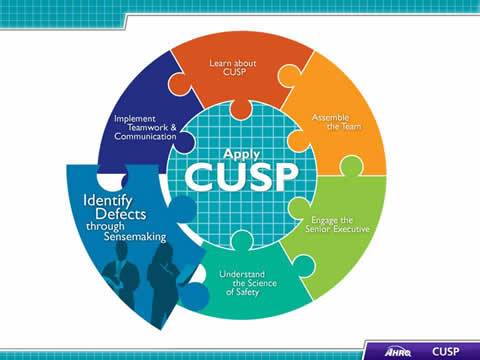
Say:
The "Identify Defects Through Sensemaking" module of the Comprehensive Unit-based Safety Program (or CUSP) Toolkit will help you identify recurring defects in your system and apply CUSP and Sensemaking tools to help reduce the risk of future harm to your patients.
[D] Select for Text Description.
Slide 2: CUSP and Sensemaking Tools1

Say:
Some of the tools that will help CUSP teams identify and learn from defects include:
- The Staff Safety Assessment, which provides unit teams a structured approach to assessing the patient safety culture on the unit.
- The Safety Issues Worksheet, for Senior Executive Partnership, which offers unit teams an organized method for identifying, characterizing, and bringing safety issues to the attention of the senior executive partnership to address.
- The Learn from Defects Form, which provides a standardized means to assess where defects occur and to develop an action plan to correct them.
A number of Sensemaking tools are also available.
Sensemaking tools supply a systematic approach to event reporting.
Sensemaking can be applied to the analysis of individual events or specific systems.
One Sensemaking tool that will help CUSP teams identify and learn from defects is the Discovery Form, which serves several vital functions that provide unit teams a structured approach to:
- State when and where an event was discovered.
- Determine the number of barriers or critical control points that were breached before the incident was revealed.
- Specify the event’s consequences, if they are known.
- Identify individuals who might have been involved in the occurrence, and
- Document (a) the actions taken to reduce the unfavorable outcome of the incident and (b) the recovery actions staff took following the discovery of the incident.
Another tool is Root Cause Analysis, which provides a systematic approach to analyzing an event. Staff members are responsible for investigating the causes of an incident or near-miss event, generally with the intention of creating changes to prevent it from recurring.
The Failure Mode and Effects Analysis tool provides a way to conduct a step-by-step analysis staff can use to understand how the various parts of a process could go wrong.
A failure mode and effects analysis is different from a root cause analysis, in that the failure mode and effects analysis searches for all possible ways in which an event could occur, while the root cause analysis focuses on the main cause of the event.
Probabilistic Risk Assessment, sometimes called a probabilistic safety assessment or probabilistic safety analysis, is used in addition to the Failure Mode and Effects Analysis to evaluate risk in complex processes.
Another Sensemaking tool is the Causal Tree Worksheet, which helps teams identify and map out the causes and effects of defects in the unit. Mapping these items helps teams solve breakdowns in processes and operations.
The last tool is the Eindhoven Model, which is a near-miss model used to investigate medical staff’s actions to convert a potentially harmful event into a near-miss event. It looks at human failure, technical failure, and organizational failure.
[D] Select for Text Description.
Slide 3: Learning Objectives
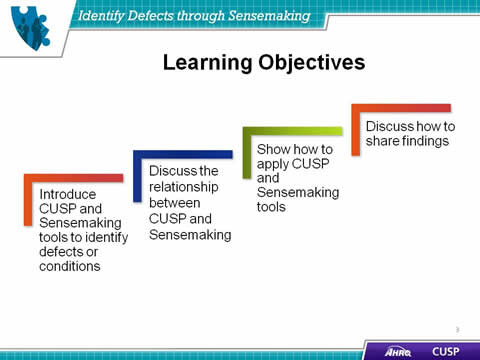
Say:
In this module, we will:
- Introduce CUSP and Sensemaking tools to identify defects or conditions.
- Discuss the relationship between CUSP and Sensemaking.
- Show how to apply CUSP and Sensemaking tools, and
- Discuss how to share findings.
[D] Select for Text Description.
Slide 4: The Relationship Between CUSP and Sensemaking1, 2, 3
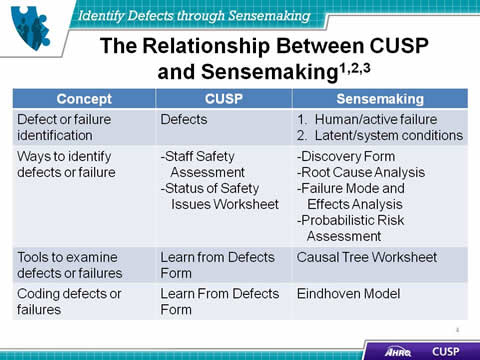
Say:
CUSP and Sensemaking employ similar defect identification and solving skills.
Defects identification
CUSP asks unit staff to work through a defect and ask:
- What happened?
- Why did it happen?
- What will you do to reduce risk?
- How will you know that you actually succeeded?
By engaging in this learning process, providers can uncover contributing system-level failures that influenced the defect.
Sensemaking calls for staff to work through the failure, identifying the latent and active contributors to it.
Active failures are also called human error. Active failures are categorized in three main types: skill-based, rule-based, and knowledge-based.
- Skill-based failures happen when a person fails in the performance of a routine task that normally requires little conscious effort.
- A rule-based failure occurs when a person does not carry out a procedure or protocol correctly or chooses the wrong procedure or rule.
- A knowledge-based failure happens when a person is unable to apply existing knowledge to new situations.
Latent conditions result from the delayed consequences of technical and organizational actions and decisions. These conditions are the mistakes that occur without human error. Latent conditions are sorted into two categories: technical failures and organizational failures.
- Technical failures are problems with physical items, such as equipment and software.
- Organizational failures occur when decisional elements, such as culture, procedures, and leadership decisions challenge safety.
Tools to identify defects or failures
When identifying defects or failures, CUSP uses the Staff Safety Assessment and the Safety Issues Worksheet for Senior Executive Partnership.
To accomplish the same work, Sensemaking uses the Discovery Form, the Root Cause Analysis, the Failure Mode and Effects Analysis, and the Probabilistic Risk Assessment.
To examine defects or failures, CUSP uses the Learn from Defects Form, and Sensemaking uses the Causal Tree Worksheet.
To code defects or failures, CUSP uses the Learn from Defects Form, and Sensemaking uses the Eindhoven Model.
By addressing these areas through the use of both CUSP and Sensemaking ideas, skills, and tools, teams will be able to analyze defects on their units and design effective interventions to fit their needs.
[D] Select for Text Description.
Slide 5: Identify Defects and Use Sensemaking
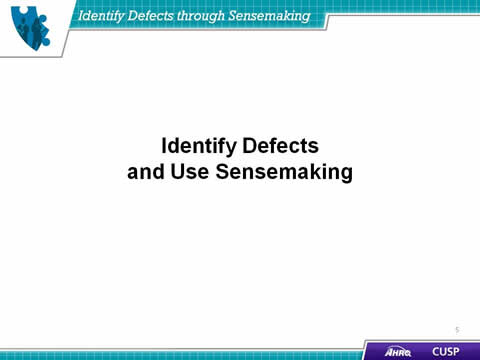
Say:
We will now explore an overall plan for addressing barriers to identifying defects and for collaborating to alleviate them. Staff collaboration to define defects and identify their sources contributes to staff awareness and the effectiveness of the intervention.
[D] Select for Text Description.
Slide 6: Identify Defects Overview
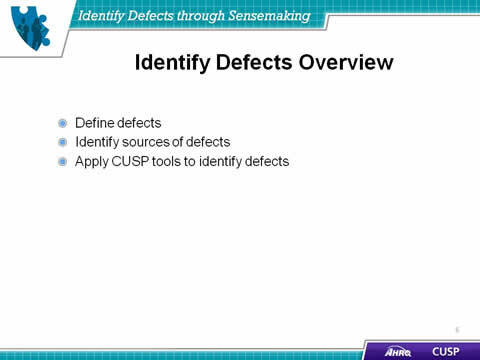
Say:
When collaborating with frontline staff to identify defects on the unit, the CUSP team will apply CUSP tools to identify defects, define them, and identify their sources.
[D] Select for Text Description.
Slide 7: Sensemaking Overview4
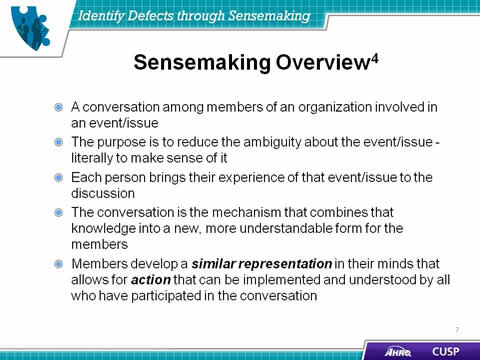
Say:
Sensemaking, in the context of patient safety, is used to describe a deliberate process of reflection on failures or near misses. Sensemaking is a way for a unit to learn from and prevent mistakes. Sensemaking has five attributes:
First, Sensemaking involves a conversation among team members. When engaging in Sensemaking, teams retrospectively assign meaning to ambiguous events or data. This act provides them an opportunity to collaborate to carry out a sustainable intervention on their unit.
Second, Sensemaking reduces the ambiguity of the event or issue by providing teams the tools and resources needed to make sense of a failure that occurred on their unit. By doing this, teams are able to assign meaning to the system breakdowns that occur on their units.
Third, Sensemaking engages the experiences of team members. Sensemaking calls for the involved unit members to share their experiences as firsthand experts on the contributors to the failure. The intent of sharing is to have only the individuals involved in the event, rather than their representatives or other staff, provide their interpretation of the events.
Fourth, Sensemaking employs conversation to create new knowledge. Sensemaking calls for teams to collaboratively seek a solution to the failure identified on their unit. The conversation builds an understanding of how one part of the system interacts with other parts that safeguard or produce gaps in the system.
Fifth, team members develop a shared understanding of the failure and develop an action plan to address the failure. Sensemaking calls for team members to develop a representation similar to the failure and use it to develop and implement an action plan for their unit. Staff must recognize that any element of the plan that takes action to prevent failures will affect other elements of the representation, sometimes with poor outcomes. By involving multiple parts of the representation in the Sensemaking conversation, the changes designed in one area can be safeguarded in another, increasing the effectiveness of interventions.
[D] Select for Text Description.
Slide 8: Examples of Defects or Failures That Affect Patient Safety
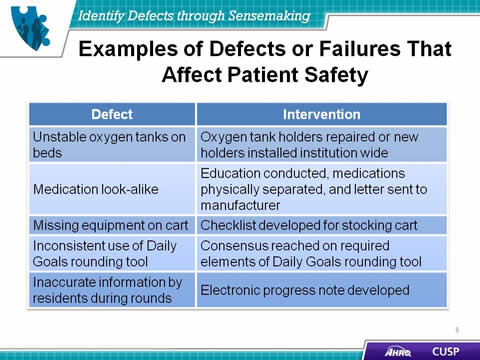
Say:
When identifying defects that affect patient care, team members who know how a defect will affect patient safety can help the team prevent the defect as well as a sentinel event. In doing this, team members understand the relationship between defects and production pressures—leaving hazards unnoticed until a sentinel event occurs.
Examples of defects that affect patient safety and interventions put in place to alleviate them include:
- Unstable oxygen tanks on beds: Oxygen tank holders were repaired or new holders were installed institution wide.
- Medication look-alikes: Staff were educated about medication similarities and the physical separation of drugs, and staff sent a letter to a drug manufacturer to request different labeling.
- Missing equipment on a cart: Staff developed a checklist to assign responsibility for stocking supplies on the cart.
- Inconsistent use of Daily Goals Checklist tool during patient rounds: The staff reached consensus regarding the elements of the tool to be applied during rounds.
- Residents report receiving inaccurate information during rounds: An electronic progress note system was developed to maintain accurate information exchanges on the unit.
[D] Select for Text Description.
Slide 9: Reason’s Swiss Cheese Model5
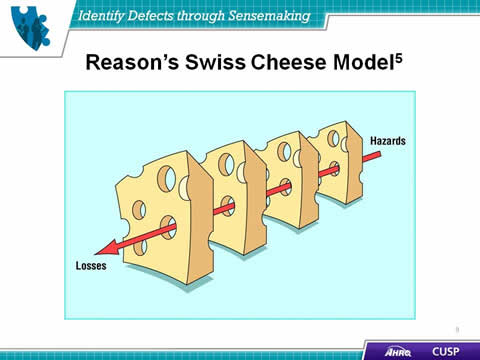
Say:
When combating defects on the unit, it is important for staff to understand where and how breakdowns in safety occur. The Swiss cheese model portrays how defects permeate the unit-level systems and contribute to patient harm. The cheese itself represents the unit-level systems, and the holes that are synonymous with Swiss cheese symbolize the opportunities for defects to permeate established systems and cause patient harm. As exemplified on the previous slide, defects can be found everywhere on the unit. Bearing this in mind, unit staff members are responsible for being aware of their patients and the environment to prevent defects from permeating their systems and contributing to patient harm.
[D] Select for Text Description.
Slide 10: CUSP Tools To Identify Defects
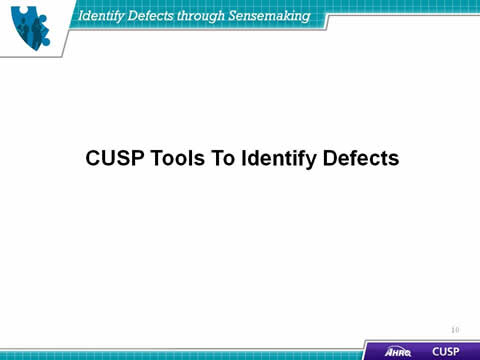
Say:
When using CUSP on the hospital unit, teams will be able to use the following tools to help engage health care providers in identifying defects.
[D] Select for Text Description.
Slide 11: Staff Safety Assessment
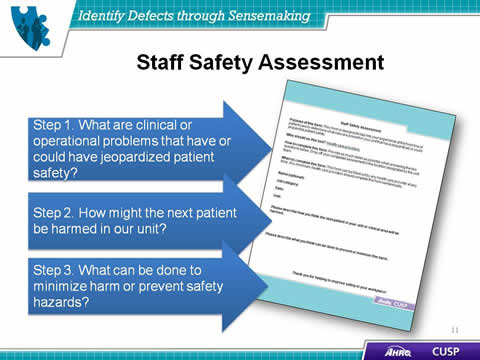
Say:
The CUSP Staff Safety Assessment is an effective and proactive tool for identifying defects. It helps teams ask three simple questions about the issue of patient safety on their unit:
- What clinical or operational problems have or could have endangered patient safety?
- How might the next patient be harmed in our unit?
- What can be done to minimize harm or prevent safety hazards?
The Staff Safety Assessment is designed for all health care providers to use. Staff should provide as much detail as possible when completing the assessment, especially the second question. The objective of this form is to access the knowledge at the frontlines of patient care to determine what risks are present that have jeopardized or could jeopardize patient safety on a unit. Frontline staff members are the eyes and ears of patient safety. Data they provide can be used to prepare a list of improvement opportunities that has face validity and creates a focus for CUSP activities.
Use the Staff Safety Assessment results to:
- Report defects to staff and the senior executive.
- Prioritize defects by the potential level of risk to one or more patients.
- Select one defect to address with the support of the senior executive, and
- Develop a plan for the selected defect.
Additionally, CUSP teams should:
- Identify at least one defect each quarter, and
- Ensure identification of defects is an ongoing process.
[D] Select for Text Description.
Slide 12: Exercise
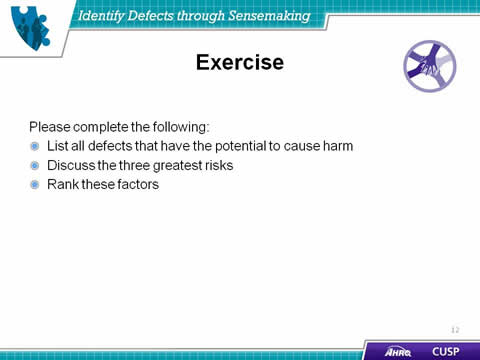
Say:
Using the following exercise, you can practice this process of safety assessment by completing the following:
- List all defects that have the potential to cause harm on your unit.
- Discuss the three greatest risks, and
- Rank these risk factors.
Further guidance to complete this exercise can be found using the CUSP Learn from Defects Form.
[D] Select for Text Description.
Slide 13: Use the Safety Issues Worksheet for Senior Executive Partnership
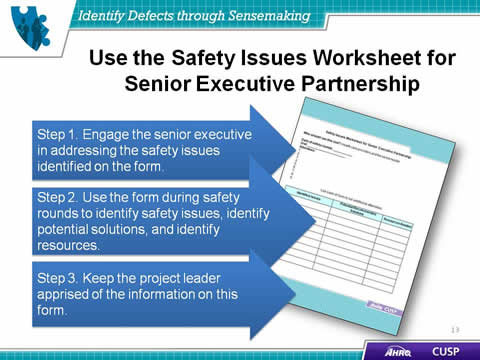
Say:
The goal of using the Safety Issues Worksheet for Senior Executive Partnership is to:
- Engage the senior executive in addressing the safety issues identified on the form.
- Identify safety issues, potential solutions, and resources during safety rounds; and
- Keep project leaders apprised of the information on this form.
Senior executives should be members of CUSP teams. The senior executive partner can use the Safety Issues Worksheet for Senior Executive Partnership to track what they observe during rounds on their CUSP units. Using the worksheet during rounds can help the senior executive identify safety issues, potential solutions, and needed resources.
During rounds, each senior executive is given an opportunity to see firsthand the possible defects in the hospital rather than receive a report about them. The senior executive also has a chance to support the CUSP team leader with solutions for the identified issues and ensure the CUSP team has the resources needed to implement the intervention that the unit team devises.
The Safety Issues Worksheet for Senior Executive Partnership will help the CUSP team keep its team leader abreast of the happenings with the senior executive partnership and the intervention on the unit. Because the senior executive’s actions related to the project are recorded on this form, the CUSP team lead will be able to review the senior executive’s progress on the intervention.
To use the Safety Issues Worksheet for Senior Executive Partnership:
- Transfer the safety issues from Staff Safety Assessment to the worksheet.
- Assign a contact person to champion all activities associated with each safety issue on the worksheet.
- Move resolved issues to the completed section of the worksheet.
- Share the worksheet with the unit champion to keep frontline providers updated about the progress of interventions.
[D] Select for Text Description.
Slide 14: Sensemaking Tool To Identify Defects: Root Cause Analysis
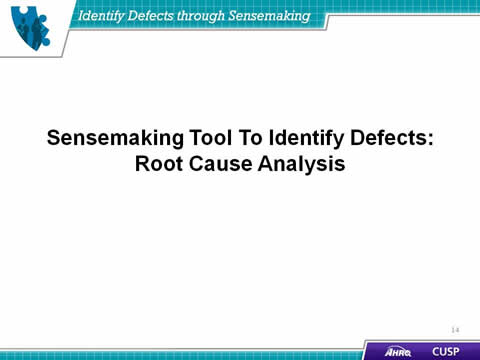
Say:
Related to CUSP tools to identify defects, Sensemaking tools such as Root Cause Analysis will help providers understand the consequences of a failure and avert future harm for patients.
[D] Select for Text Description.
Slide 15: Root Cause Analysis: Causal Tree Worksheet6
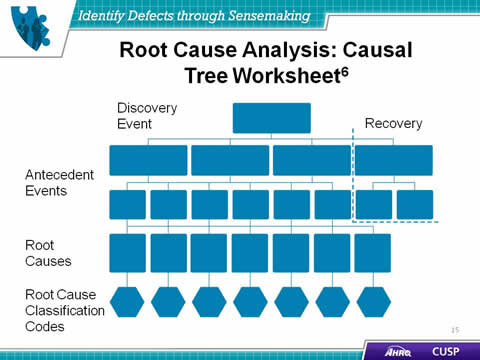
Say:
Here is an example of a root cause analysis causal tree template. Your tree will look different because it will be based on the failure that took place within your unit and the information gathered through the Sensemaking process.
A causal tree can be built in many ways. In this example, we will start with the discovery event and work backward through time, asking a series of "why's" to reach the root causes of the event.
On this worksheet, you see both a failure and a recovery side. The recovery side is completed when the event is a near-miss, that is, something that happened to stop the event from reaching the patient.
The recovery side of the tree usually resembles a "mini tree." It is seldom more than three boxes. Sometimes only one box represents the recovery step that took place.
The last step in building a causal tree is to assign causal codes.
The bottom of each branch of the causal tree represents the root causes. Root causes are assigned, coded, and entered into hexagons at the bottom of each branch.
The consequent, or discovery, event is located at the top of the causal tree. It is imperative to define the consequent event correctly because the rest of the tree will flow from it.
The consequent event is described in terms of the event's consequences:
- Harm that did happen.
- Harm that did not happen—No harm event.
- Event did not reach the patient—Near-miss event.
We then ask why this consequence occurred.
An antecedent describes the preceding event, condition, or cause. Antecedent events are those actions and decisions that led up to the consequent event. Remember to consider both active failures and latent conditions.
There is no absolutely correct method of building a causal tree. The tree is an interpretation of the event. Additional information discovered during investigation may cause the tree to grow. And different tree compositions for the same event could possibly yield the same root causes.
[D] Select for Text Description.
Slide 16: Root Cause Analysis Example6
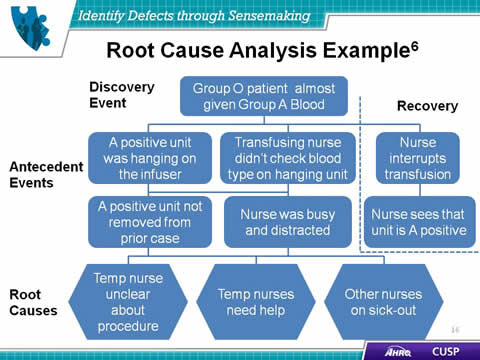
Say:
Let's work our way across this tree. Top-level antecedent events are those that immediately precede and result in the consequent event. From these events, we can work our way down to the root causes.
What do you think is the initial antecedent event?
Through your investigation, you learn that an unused A positive unit was left on the infusion pump from a prior case.
So when we ask: "What antecedent events can we determine for this consequent event?" One answer is: "An A positive unit was hanging on the infuser."
"And?"
"And the transfusing nurse didn't check the blood type on the unit that was hanging."
We continue to ask, "And what else?" until there are no more reasons on this branch of the tree. For this example, we will stop at only two antecedent events.
Next we ask: "Why was the A positive unit hanging on the infuser?"
"Because the unit wasn't removed from a prior ED case."
"Why?"
"Why wasn't the unit removed from a prior case?"
"Because the temporary nurse was unclear about the proper procedure."
When you can no longer answer "why," you have reached a root cause, and you do not proceed further with that branch of the tree. Without additional information or a more complete investigation, we cannot move further down the first branch of this tree.
In this case, we will stop this branch here.
We now ask why the transfusing nurse didn't check the blood type on the unit that was hanging.
"Because the nurse was busy and distracted."
"Why?"
"Because the regular nurses were on a sick-out, and the temporary nurses didn't know this hospital's procedures or where supplies were located, and they needed help."
Normally we would keep asking "why" or "and" until we were convinced we had captured the entire picture.
For this example, we will now move on to review the recovery in this event.
In this case example, another nurse interrupted the transfusion from proceeding by asking, "How did you get type-specific blood so quickly?"
Why did she ask this? Because she noticed that the unit hanging is an A positive and realized that this is very unusual for an emergency case. This is an unplanned recovery.
[D] Select for Text Description.
Slide 17: Learning From Defects and Sensemaking
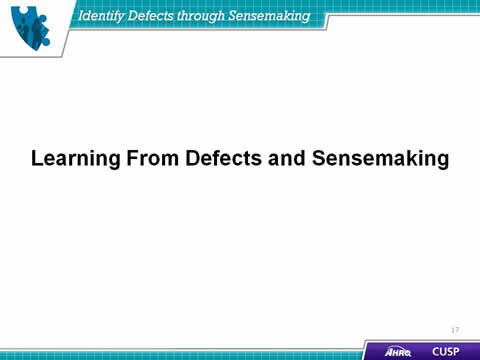
Say:
Learning from defects and Sensemaking principles are closely aligned. Making use of these ideas on the unit will help teams understand where breakdowns occur and collaborate to bring about a sustainable solution to the failure identified.
[D] Select for Text Description.
Slide 18: Learning From Defects Overview
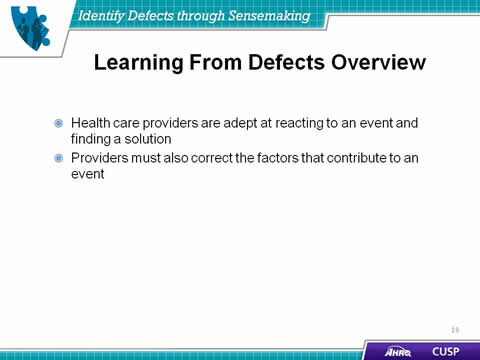
Say:
Learning from defects often reveals that systems contribute to the underlying causes of the defects. As noted in the "Understand the Science of Safety" module, every system is perfectly designed to achieve the results it obtains.
Learning from defects can also be called second-order problemsolving. Health care providers have become very adept at first-order problemsolving, which is recovery problemsolving. This problemsolving method approaches a defect by reacting to an issue, finding its solution, and moving on. While this is commendable and necessary, it is also vital to learn from the defect and then apply second-order problemsolving—where the underlying causes and processes are examined—to correct the factors contributing to the event.
[D] Select for Text Description.
Slide 19: Exercise
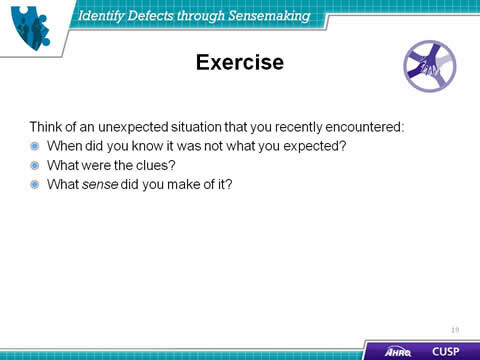
Say:
Think of an unexpected situation that you recently encountered.
- When did you know it was not what you expected?
- What were the clues?
- What sense did you make of it?
[D] Select for Text Description.
Slide 20: CUSP Tools To Learn From Defects
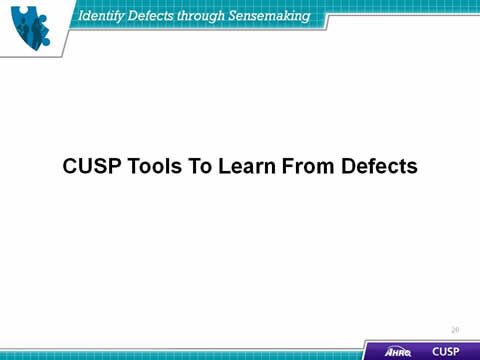
Say:
CUSP includes tools specifically designed for unit teams to learn from defects they have identified on their unit.
[D] Select for Text Description.
Slide 21: Learning From Defects: Four Questions
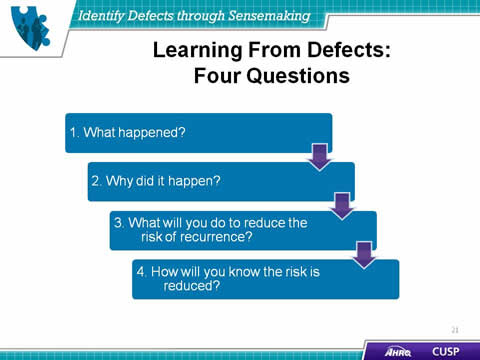
Say:
When learning from defects, the following questions should be used to guide the assessment and understanding of the event.
- What happened?
- Step 1. Reconstruct the timeline to understand what happened.
- Step 2. Put yourself in the place of those involved and in the middle of the event as it was unfolding.
- Step 3. Try to understand the thinking and reasoning behind their actions and decisions.
- Step 4. Try to view the world as they did when the event occurred.
- Why did it happen?
- Step 1. Visualize the factors that led to the event.
- Step 2. Identify the contributing factors.
- Step 3. Prioritize the contributing factors.
- What will you do to reduce the risk of recurrence?
- Step 1. Develop interventions for two to five of the most important factors.
- Step 2. Rate the interventions.
- Step 3. Select the highest-rated interventions.
- Step 4. Develop an action plan for implementation.
- How will you know the risk is reduced?
- Question 1. Did you create a policy or procedure (rate strong or weak)?
- Question 2. Do staff members know about the policy or procedure?
- Question 3. Are staff members using the procedure as intended?
- Question 4. Do staff members believe risks were reduced?
[D] Select for Text Description.
Slide 22: What Happened?
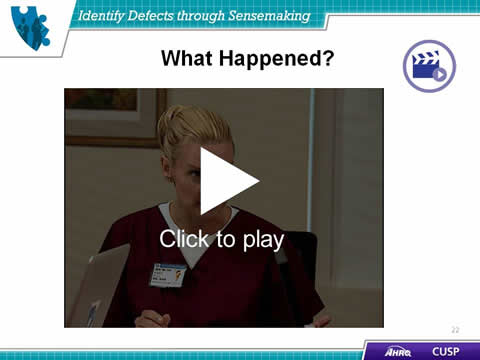
Do:
Play the video.
Ask:
- What defect did the team lead identify for the group to discuss?
- What happened to the patient?
[D] Select for Text Description.
Slide 23: Why Did It Happen?
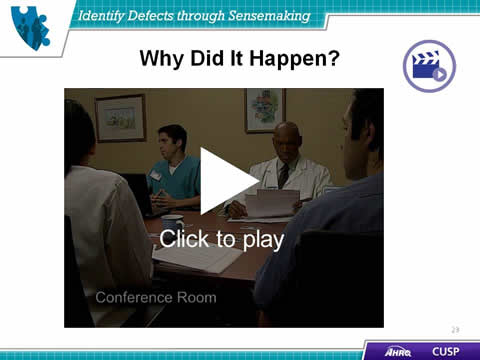
Do:
Play the video.
Ask:
- According to the nurse, what happened?
- What did the nurse need from the ICU doctor to stop administering the antibiotic?
- According to the team lead, where did communication fail on their unit?
[D] Select for Text Description.
Slide 24: What Will You Do To Reduce the Risk of Recurrence?
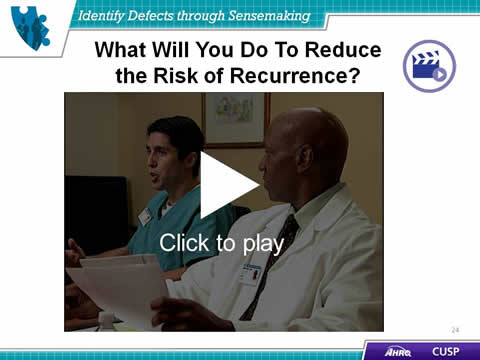
Do:
Play the video.
Ask:
- What does the nurse suggest that the team do to reduce the likelihood of the defect occurring again?
- What does the surgeon suggest other surgeons do to alleviate the defect?
- What does the pharmacist suggest other pharmacists do to alleviate the defect?
- How do you think these steps will alleviate the defect on the unit?
[D] Select for Text Description.
Slide 25: How Will You Know the Risk Is Reduced?
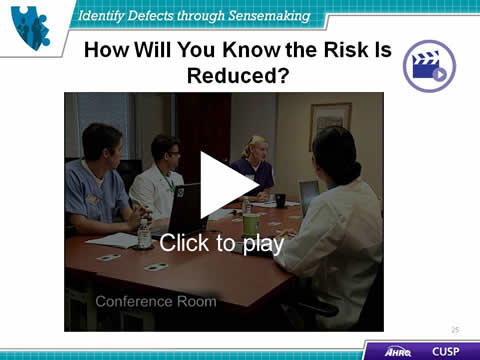
Do:
Play the video.
Ask:
- What good news does the team lead share with the CUSP team?
- Why was the intervention successful?
[D] Select for Text Description.
Slide 26: Sensemaking Tools To Learn From Defects
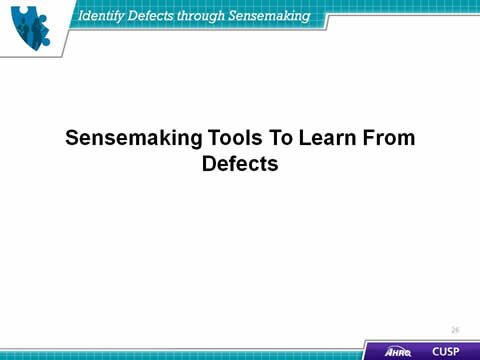
Say:
Sensemaking has unique tools to help teams learn from defects identified on their unit.
[D] Select for Text Description.
Slide 27: Causal Coding: Eindhoven Model6
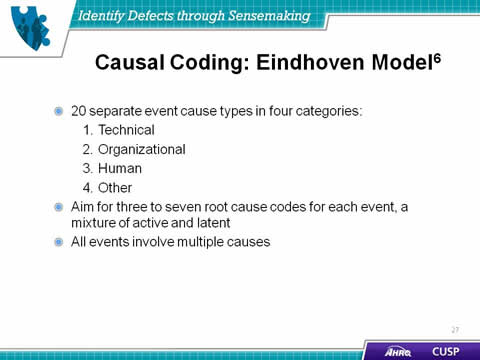
Say:
One Sensemaking model is the Eindhoven Model, which is based on earlier work in chemical plants. In this model, 20 separate event cause types are given in four categories: technical, organizational, human, and other.
Remember that all events involve multiple causes, usually of more than one type. If the analysis of an event lists only one type, then it is likely the analysis is incomplete. The Eindhoven Model allows for the coding of multiple causes and will help teams identify more than one cause of a failure.
The subcategories of technical causes are:
- Design, such as equipment design and, often, interface design;
- Construction, such as incorrectly assembled devices;
- Materials, such as a faulty seal on a pump; and
- External causes outside the unit, such as the loss of an electrical supply.
Subcategories of organizational causes include:
- Transfer of knowledge, such as a gap in new staff training;
- Protocols, such as a procedure that is impractical to apply in an emergency situation;
- Management priorities, such as inadequate staffing levels;
- Culture, such as a failure because of inappropriate deference to physicians; and
- External causes, such as a confusing regulation enforced by an outside agency.
As noted earlier, there are 20 codes that are divided into the categories of technical, organizational, human, and other. When the Eindhoven Model of analysis is completed, there should be three to seven root causes for each incident, and they should be a combination of active and latent factors.
This sequence of analysis is very important. Many times in health care, the focus starts with human factors to blame on the participants and may sometimes look at the technical factors.
The Eindhoven Model of analysis ensures the most crucial and fixable factors are addressed first, followed by human factors. Some of the codes for the factors are:
- TC: Technical, construction,
- TM: Technical, materials,
- TD: Technical, design,
- OEX: Organizational, external,
- OK: Organizational, knowledge transfer,
- OM: Organizational, management,
- HEX: Human, external, and
- HRV: Human, rule-based, verification.
[D] Select for Text Description.
Slide 28: Root Cause Analysis Example6
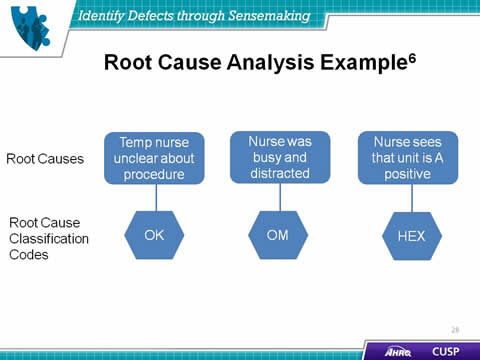
Say:
Revisiting the earlier example, the fact that the A positive unit was not removed from the prior case is coded as OK—organizational, knowledge transfer—because you learned that the temporary nurse was not fully briefed on this hospital’s procedures at the start of the shift.
Next, you learned that many regular nurses were on sick-out because of management’s decision to decrease vacation benefits. This is coded as OM—organizational, management.
Finally, the temporary nurses needed help because they were from outside the agency. This is coded as HEX—human, external to the organization.
If this case were fully entered into the causal tree, there would be more boxes and root causes.
[D] Select for Text Description.
Slide 29: CUSP and Sensemaking: Next Steps
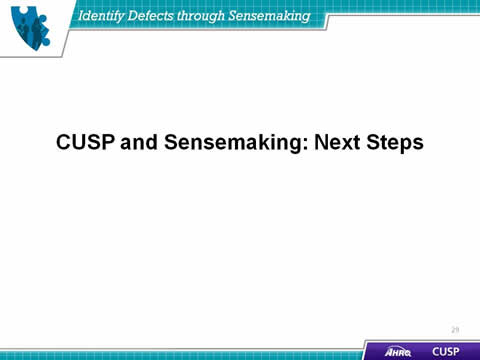
[D] Select for Text Description.
Slide 30: Summarize and Share Findings
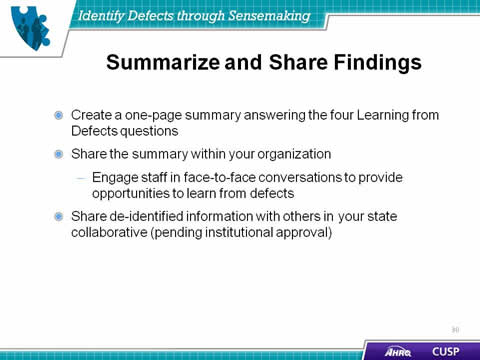
Say:
After working through the Sensemaking and learn from defects processes, teams will be able to summarize and share their findings with their colleagues and senior management.
- Create a one-page summary answering the four learn from defects questions.
- Share the summary within your organization.
- Engage staff in face-to-face conversations to provide opportunities to learn from defects.
- Share de-identified information with other teams.
[D] Select for Text Description.
Slide 31: Communicating the Learning
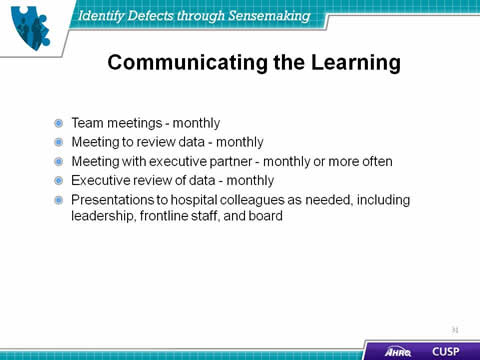
Say:
To facilitate communication about what the team learned by identifying defects through Sensemaking, the CUSP team will:
- Attend monthly CUSP team meetings.
- Review data each month.
- Review data with the senior executive each month.
- Present findings to hospital colleagues as needed, including leadership, frontline staff, and the hospital board.
[D] Select for Text Description.
Slide 32: Summary: Sensemaking and Identifying Defects
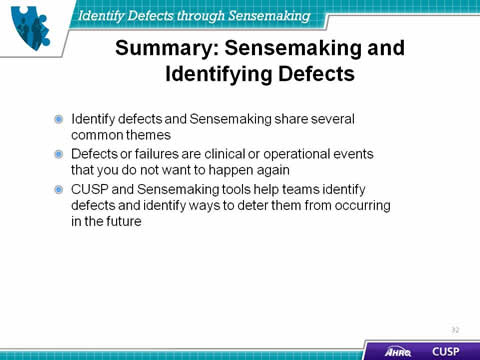
Say:
In summary:
- Identifying defects and Sensemaking share several common themes.
- Defects are clinical or operational events that you do not want to happen again.
- CUSP and Sensemaking tools help teams identify defects and identify ways to prevent them from occurring in the future.
[D] Select for Text Description.
Slide 33: Summary of Sensemaking and Learning From Defects
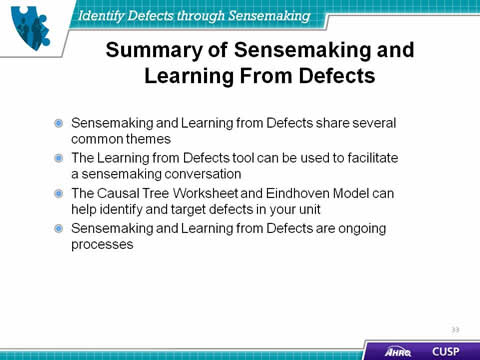
Say:
Additionally:
- Sensemaking and learning from defects share several common themes.
- The Learn From Defects Form can be used to facilitate a Sensemaking conversation.
- The Causal Tree Worksheet and Eindhoven Model can help identify and target defects in your unit.
- Sensemaking and learning from defects are ongoing processes.
[D] Select for Text Description.
Slide 34: References
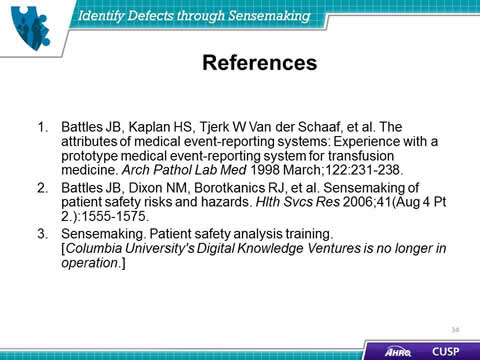
References
[D] Select for Text Description.
Slide 35: References
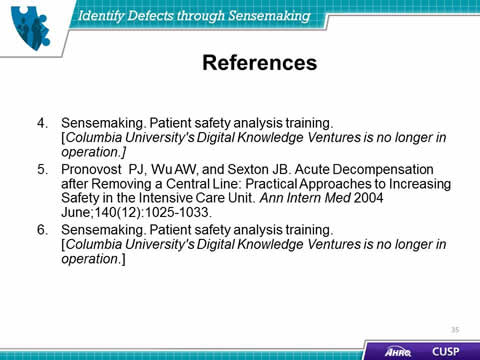
References
[D] Select for Text Description.



